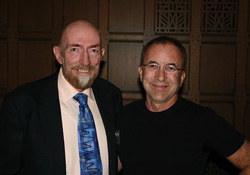Feynman’s Vision
TEDxCaltech Celebrates the Vision of Richard Feynman

On Friday, January 14, 2011, the spirit of TED (Technology, Entertainment, Design) was enacted as TEDxCaltech, one of many independent lecture series that have spontaneously emerged from the bottom up by what I call “ideas entrepreneurs,” creative individuals who want to change the world by spreading ideas in the format modeled after the annual event now held in Long Beach (albeit at a fraction of the cost: $85 versus $6000). The theme of TEDxCaltech was “Feynman’s Vision: The Next 50 Years,” celebrating Richard Feynman’s famous 1959 lecture, “There’s Plenty of Room at the Bottom,” which helped launch the field of nanotechnology. As Feynman said, “Our imagination is stretched to the utmost, not, as in fiction, to imagine things which are not really there, but just to comprehend those things which are there.”
Feynman was famous for telling stories, so first up on the morning program was Feynman’s daughter Michelle, who recounted what it was like to hear bedtime stories from her famous father. Michelle then introduced Christopher Sykes, the British documentary film maker who cast Feynman’s stories into filmic narrative in his famous film The Pleasure of Finding Things Out (the phrase inspired by a Feynman quip about why he does science—not to change the world or discover some grand unifying theory of everything, but just for the pleasure of finding things out). Sykes recounted how intimidating it was to initially approach the normally reclusive Feynman with the idea of sitting him down in front of a camera, but Feynman agreed, perhaps because he knew his life was coming to an end because of cancer, or perhaps because Sykes is such a warm and engaging man. Whatever the reason, the world is a better place with Feynman’s voice still engaging us two decades after his death (you can watch excerpts from the film on YouTube).
The talks throughout the day were peppered by video clips of Feynman, plus musical performances inspired by Feynman’s passion for drumming. But the meat of the day was in the lectures by scientists, grad students, and even undergrad students who have carried on Feynman’s vision in various fields. To wit, Curtis Wong, a Principal Researcher in eScience at Microsoft introduced us to WorldWideTelescope.org, “a free interactive storytelling and virtual learning environment providing the highest resolution multispectral imagery of the universe.” It is a 3D tour of the universe, inspired by Feynman’s creative genius in visualizing data in a manner that enhances understanding.
The afternoon sessions of heavy-duty science and technology talks were broken up with some seriously geeky humor when Caltech cosmologists Kip Thorne (whom I posed with in the picture) and John Preskill played a science-geek version of Who Wants to be a Millionaire, complete with the music, rotating spot lights between questions, and slides projecting the question and four-answer options on the screen. Since TEDxCaltech was a tribute to Feynman, all questions pertained to things that Feynman said or did, so of course the correct answer to every question was “Richard Feynman.” Nevertheless, Thorne and Preskill could not seem to agree on an answer so they had to use their three lifelines: 50/50, poll-the-audience, and phone-a-friend. The first question was:
“Who said ‘If you think you understand quantum mechanics, you don’t understand quantum mechanics.’?”
Answer choices:
- George W. Bush
- Lady Gaga
- Albert Einstein
- Richard Feynman
For this question Thorne and Preskill used their 50/50 lifeline and narrowed it down to Einstein or Feynman, and they correctly guess the latter because the former never fully accepted quantum mechanics, much less understood it.
The next two questions went the same way, forcing Thorne and Preskill to poll the audience (we got it right: “Richard Feynman”) and, finally, to phone-a-friend. For the latter, Thorne and Preskill deduced that the answer was either Stephen Hawking or Richard Feynman, so they chose to phone no less an expert than Stephen Hawking, who not only answered his phone, but when Thorne asked him to please come to Caltech to answer the question, there he was, wheeling down the aisle of Beckman Auditorium at Caltech and up onto the stage, where he promptly answered, “Richard Feynman. That’s my final answer.”
The day wrapped up with speakers discussing Feynman diagrams, the squiggly lines that help particle physicists visualize what interacting subatomic particles are doing when they collide in atom smashers. Even though Feynman diagrams are so useful that they appear on blackboards in physics departments around the world—and even on the side of Feynman’s van—additional discussions noted how difficult it is to actually compute mathematically what is really happened in even the simplest of particle interactions depicted in such diagrams. Nonetheless, Feynman’s vision, and his legacy lives on.





